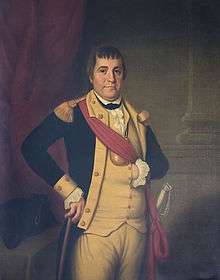William Barton (soldier)

William Barton (1748—1831) was an officer in the Continental Army during the American Revolutionary War who retired with the rank of colonel. He later served as adjutant general of the Rhode Island militia.
Early years and enlistment
Barton was born in Warren, Rhode Island on May 26, 1748. He worked as a hatter in Providence, Rhode Island. In 1771, he married Rhoda Carver. In 1775, he enlisted in the Continental Army as a corporal. He fought in the Battle of Bunker Hill.
Commissioned officer
On August 2, 1775 he was appointed the adjutant of Richmond's Rhode Island Regiment. He was promoted to captain on November 1, 1775.
In late June and early July 1777, as a major in the Rhode Island state troops, he planned and led a raid on British headquarters, capturing Major General Richard Prescott. On the night of July 10–11, with 38 men and six officers in five whaleboats, Barton crossed Narragansett Bay, passed unobserved by three British frigates, and, landing about halfway between Newport and Bristol Ferry, went to the farm house where Prescott had his headquarters. The guards were surprised, the door of Prescott's room was broken in, and the general was hurried away half dressed and taken to Warwick Point, and afterward to Providence. For this exploit, the Continental Congress gave Barton a sword and passed a resolution honoring his service.
Barton was promoted to lieutenant colonel on November 10, 1777 and was made colonel of Stanton's regiment of the Rhode Island Militia with "rank and pay of colonel in the Continental Army" upon the resignation of Colonel Joseph Stanton, Jr.. He was gravely wounded in the thigh while trying to rally American militia to attack the rear guard of a British raidng party that burned parts of Bristol and Warren, Rhode Island, on May 25, 1778. He never fully recovered from this injury, but did return in June 1779 to lead a company of light infantry operating in boats in Narragansett Bay. He served until the end of the war.[1]
After the revolution
In 1783 Barton became an original member of the Rhode Island Society of the Cincinnati.
When Rhode Island ratified the United States Constitution in 1790, Barton was sent to New York to notify George Washington.[2]
He helped to found the town of Barton, Vermont. Subsequently, Barton was successfully sued in court for selling the same land to two different parties. He was sued in court and lost. He refused to pay this debt. For this he was ultimately confined to the debtors' prison in Danville for 14 years, starting at the age of sixty-four. At the age of seventy-seven, he was released at the initiative of the visiting Marquis de Lafayette, who agreed to pay the balance of his debt.[3]
Death and legacy
Barton died on October 22, 1831, at the age of eighty-three. He is buried in the North Burial Ground in Providence, Rhode Island. Fort Barton in Rhode Island was named after William Barton. It is now a park owned by the town of Tiverton, Rhode Island. Fort Barton Elementary School is also in Tiverton, Rhode Island.
References
- ↑ McBurney, Christian, Kidnapping the Enemy: The Special Operations to Capture Generals Charles Lee and Richard Prescott, 190-91; McBurney, Christian, The Rhode Island Campaign: The First French and American Special Operation of the Revolutionary War, 61-62; Heitman's Register of Continental Army Officers. p. 77.
- ↑ "Journal of the U.S. Senate, Tuesday, June 1, 1790". Library of Congress. Retrieved 11 February 2012.
- ↑ Dunbar, Bethany M. (June 26, 2013). "Barton's hydroelectric history is revisited". The Chronicle. Barton, Vermont. pp. 1B.
External references
- McBurney, Christian. Kidnapping the Enemy: The Special Operations to Capture Generals Charles Lee and Richard Prescott. Yardley, PA: Westholme Publishing, 2014. ISBN 978-1-59416-183-4. This book has as one of its main focuses Barton's capture of General Prescott and Barton's life after the war, including the story of his spending 14 years in a Vermont debtors' prison.
- Boatner, Mark Mayo, III. Encyclopedia of the American Revolution. Revised ed. New York: McKay, 1974. ISBN 0-8117-0578-1.
- Falkner, Leonard. "Captor of the Barefoot General". American Heritage Magazine 11:5 (August 1960).
- Heitman, Francis B. Historical Register of Officers of the Continental Army during the War of the Revolution. New, enlarged, and revised edition. Washington, D.C.: Rare Book Shop Publishing Company, 1914. Available on Google Book Search, page 90 shows Barton's service record and dates of promotions.
 This article incorporates text from a publication now in the public domain: Wilson, James Grant; Fiske, John, eds. (1900). "Barton, William". Appletons' Cyclopædia of American Biography. New York: D. Appleton.
This article incorporates text from a publication now in the public domain: Wilson, James Grant; Fiske, John, eds. (1900). "Barton, William". Appletons' Cyclopædia of American Biography. New York: D. Appleton.- McBurney, Christian. The Rhode Island Campaign: The First French and American Operation of the Revolutionary War. Yardley, PA: Westholme, Publishing, 2011. ISBN 978-1-59416-134-6.
External links
- William Barton at "Find a Grave"
- "Colonel William Barton" from the Aquidneck Island Chapter of the Daughters of the American Revolution, Newport, Rhode Island
Further reading
McBurney, Christian M. (2013). Kidnapping the enemy. The Special Operations to Capture Generals Charles Le & Richard Prescott. Westholme Publishing. p. 234. ISBN 978-1594161834.